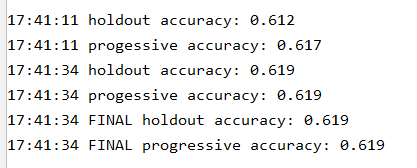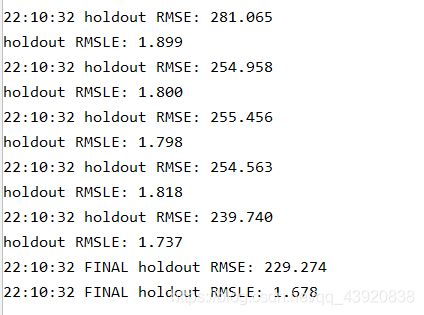python大规模机器学习day9-使用SGD
使用SGD
实验要求:
1.重新排列数据
2.训练SGDClassifier
实验内容:
1.重新排列数据和SGD的训练器预测准确度
代码注释:
代码1:
import zlib //zlib用于数据压缩
from random import shuffle
def ram_shuffle(filename_in,filename_out,header=True):
with open(filename_in,‘rb’) as f:
zlines = [zlib.compress(line,9) for line in f] //compress函数用于压缩对象
if header:
first_row = zlines.pop(0) //pop用于移除属性栏
shuffle(zlines) //shuffle函数可以随机排序
with open(filename_out,‘wb’) as f: //wb用于写数据
if header:
f.write(zlib.decompress(first_row)) //decompress用于解压缩数据
for zline in zlines:
f.write(zlib.decompress(zline))
import os
local_path=os.getcwd()
source = ‘covtype.data’
ram_shuffle(filename_in=local_path+’\’+source,filename_out=local_path+’\shuffled_hour.data’,header=True)
代码2:
import csv, time
import numpy as np
from sklearn.linear_model import SGDClassifier
source=‘shuffled_covtype.data’
SEP=’,’
forest_type=[t+1 for t in range(7)]
SGD=SGDClassifier(loss=‘log’,penalty=None, random_state=1,average=True)
accuracy=0
holdout_count=0
prog_accuracy=0
prog_count=0
cold_start=200000 //冷启动值
k_holdout=10
with open(local_path+’\’+source, ‘rt’) as R:
iterator = csv.reader(R, delimiter=SEP)
for n,row in enumerate(iterator):
if n>250000: # Reducing the running time of the experiment //设置了限制器来观察250000个实例
break
# DATA PROCESSING
response = np.array([int(row[-1])]) #The response is the last value //array用于创造一个数组对象 //拿出最后一列作为样本标签值,row已经代表行,row[-1]就代表行中最后一个,即最后一列
features = np.array(list(map(float,row[:-1]))).reshape(1,-1) //reshape用于指定矩阵格式
#MACHINE LEARNING
if (n+1) >= cold_start and (n+1-cold_start) % k_holdout==0: //每10个被用于验证
if int(SGD.predict(features))==response[0]: //predict是训练后返回预测结果,返回的是标签值,训练数组有两组,一组是数据,一组是对应的标签值
accuracy +=1 //准确度计数器
holdout_count +=1 //总测试实例计数器
if (n+1-cold_start) % 25000 ==0 and (n+1) > cold_start: //每25000个观察实例统计训练准确度
print (’%s holdout accuracy: %0.3f’ % (time.strftime(’%X’), accuracy / float(holdout_count))) //strftime返回当地时间
else:
# PROCESSIVE VALIDATION
if (n+1) >=cold_start:
if int(SGD.predict(features))==response[0]:
prog_accuracy+=1
prog_count +=1
if n % 25000 ==0 and n> cold_start:
print (’%s progessive accuracy: %0.3f’ % (time.strftime(’%X’), prog_accuracy/float(prog_count)))
# LEARNING PHASE //学习阶段
SGD.partial_fit(features, response, classes=forest_type) //样本数据和样本标签,所有可能类别,partial_fit就是SGD学习器方法
print (’%s FINAL holdout accuracy: %0.3f’ % (time.strftime(’%X’),accuracy/((n+1-cold_start)/float(k_holdout)))) //最终预测准确度
print (’%s FINAL progressive accuracy: %0.3f’ % (time.strftime(’%X’),prog_accuracy/float(prog_count))) //最终数据处理准确度
代码3:
import csv,time,os
import numpy as np
from sklearn.linear_model import SGDRegressor
from sklearn.feature_extraction import FeatureHasher
source=’\bikesharing\hour.csv’
local_path=os.getcwd()
SEP=’,’
def apply_log(x): return np.log(float(x)+1) //返回x的自然对数
def apply_exp(x): return np.exp(float(x))-1 //返回x的指数
SGD=SGDRegressor(loss=‘squared_loss’, penalty=None, random_state=1,average=True)
h=FeatureHasher //h作为哈希技巧的一个对象
val_rmse=0
val_rmsle=0
predictions_start = 16000 //冷启动值
with open(local_path+’\’+source,‘rt’) as R:
iterator =csv.DictReader(R,delimiter=SEP)
for n,row in enumerate(iterator):
# DATA PROCESSING
target=np.array([apply_log(row[‘cnt’])]) //和上一个例子中的row[-1]是一样的,此处也可见row的两种提取行数据的方法,索引或者标签值
features={k+’_’+v:1 for k,v in row.items() if k in [‘holiday’,‘hr’,‘mnth’,‘season’,‘weathersit’,‘weekday’,‘workingday’,‘yr’]} //items返回可遍历的键值对,上一个例子中features保存的类型是数组,这个例子中保存的是字典,保存时间信息
numeric_features={k:float(v) for k,v in row.items() if k in [‘hum’,‘temp’,‘atemp’,‘windspeed’]} //保存天气信息
features.update(numeric_features) //键值对更新,把后面的赋给前面
hashed_features = h().transform([features]) //transform得到数据的标准化
#MACHINE LEARNING
if (n+1) >= predictions_start:
#HOLDOUT AFTER N PHASE
predicted = SGD.predict(hashed_features) //得到预测后的值
val_rmse +=(apply_exp(predicted) - apply_exp(target))**2
val_rmsle += (predicted - target)**2
if (n-predictions_start+1) % 250 ==0 and (n+1) >predictions_start:
print (’%s holdout RMSE: %0.3f’ %(time.strftime(’%X’), (val_rmse/ float(n-predictions_start+1))**0.5))
print (‘holdout RMSLE: %0.3f’ % ((val_rmsle/float(n-predictions_start+1))**0.5))
else:
# LEARNING PHASE
SGD.partial_fit(hashed_features, target)
print (’%s FINAL holdout RMSE: %0.3f’ %(time.strftime(’%X’),(val_rmse/float(n-predictions_start+1))**0.5))
print (’%s FINAL holdout RMSLE: %0.3f’ %(time.strftime(’%X’), (val_rmsle/float(n-predictions_start+1))**0.5))
源代码:
import zlib
from random import shuffle
def ram_shuffle(filename_in,filename_out,header=True):
with open(filename_in,‘rb’) as f:
zlines = [zlib.compress(line,9) for line in f]
if header:
first_row = zlines.pop(0)
shuffle(zlines)
with open(filename_out,‘wb’) as f:
if header:
f.write(zlib.decompress(first_row))
for zline in zlines:
f.write(zlib.decompress(zline))
import os
local_path=os.getcwd()
source = ‘covtype.data’
ram_shuffle(filename_in=local_path+’\’+source,filename_out=local_path+’\shuffled_covtype.data’,header=True)
代码2:
import csv, time
import numpy as np
from sklearn.linear_model import SGDClassifier
source=‘shuffled_covtype.data’
SEP=’,’
forest_type=[t+1 for t in range(7)]
SGD=SGDClassifier(loss=‘log’,penalty=None, random_state=1,average=True)
accuracy=0
holdout_count=0
prog_accuracy=0
prog_count=0
cold_start=200000
k_holdout=10
with open(local_path+’\’+source, ‘rt’) as R:
iterator = csv.reader(R, delimiter=SEP)
for n,row in enumerate(iterator):
if n>250000: # Reducing the running time of the experiment
break
# DATA PROCESSING
response = np.array([int(row[-1])]) #The response is the last value
features = np.array(list(map(float,row[:-1]))).reshape(1,-1)
#MACHINE LEARNING
if (n+1) >= cold_start and (n+1-cold_start) % k_holdout==0:
if int(SGD.predict(features))==response[0]:
accuracy +=1
holdout_count +=1
if (n+1-cold_start) % 25000 ==0 and (n+1) > cold_start:
print (’%s holdout accuracy: %0.3f’ % (time.strftime(’%X’), accuracy / float(holdout_count)))
else:
# PROCESSIVE VALIDATION
if (n+1) >=cold_start:
if int(SGD.predict(features))==response[0]:
prog_accuracy+=1
prog_count +=1
if n % 25000 ==0 and n> cold_start:
print (’%s progessive accuracy: %0.3f’ % (time.strftime(’%X’), prog_accuracy/float(prog_count)))
# LEARNING PHASE
SGD.partial_fit(features, response, classes=forest_type)
print (’%s FINAL holdout accuracy: %0.3f’ % (time.strftime(’%X’),accuracy/((n+1-cold_start)/float(k_holdout))))
print (’%s FINAL progressive accuracy: %0.3f’ % (time.strftime(’%X’),prog_accuracy/float(prog_count)))
代码3:
import csv,time,os
import numpy as np
from sklearn.linear_model import SGDRegressor
from sklearn.feature_extraction import FeatureHasher
source=’\bikesharing\hour.csv’
local_path=os.getcwd()
SEP=’,’
def apply_log(x): return np.log(float(x)+1)
def apply_exp(x): return np.exp(float(x))-1
SGD=SGDRegressor(loss=‘squared_loss’, penalty=None, random_state=1,average=True)
h=FeatureHasher
val_rmse=0
val_rmsle=0
predictions_start = 16000
with open(local_path+’\’+source,‘rt’) as R:
iterator =csv.DictReader(R,delimiter=SEP)
for n,row in enumerate(iterator):
# DATA PROCESSING
target=np.array([apply_log(row[‘cnt’])])
features={k+’_’+v:1 for k,v in row.items() if k in [‘holiday’,‘hr’,‘mnth’,‘season’,‘weathersit’,‘weekday’,‘workingday’,‘yr’]}
numeric_features={k:float(v) for k,v in row.items() if k in [‘hum’,‘temp’,‘atemp’,‘windspeed’]}
features.update(numeric_features)
hashed_features = h().transform([features])
#MACHINE LEARNING
if (n+1) >= predictions_start:
#HOLDOUT AFTER N PHASE
predicted = SGD.predict(hashed_features)
val_rmse +=(apply_exp(predicted) - apply_exp(target))**2
val_rmsle += (predicted - target)**2
if (n-predictions_start+1) % 250 ==0 and (n+1) >predictions_start:
print (’%s holdout RMSE: %0.3f’ %(time.strftime(’%X’), (val_rmse/ float(n-predictions_start+1))**0.5))
print (‘holdout RMSLE: %0.3f’ % ((val_rmsle/float(n-predictions_start+1))**0.5))
else:
# LEARNING PHASE
SGD.partial_fit(hashed_features, target)
print (’%s FINAL holdout RMSE: %0.3f’ %(time.strftime(’%X’),(val_rmse/float(n-predictions_start+1))**0.5))
print (’%s FINAL holdout RMSLE: %0.3f’ %(time.strftime(’%X’), (val_rmsle/float(n-predictions_start+1))**0.5))
实验总结:
新版本print之后需要添加括号
流处理一次处理一行数据。每10个不被训练而用于验证,用来和训练结果比较,以保证训练准确。问题:为什么要冷启动?冷启动的含义在推荐系统中,相当于第一次进入程序中不立即进行推荐,而是到一定量后进行推荐。
训练器如何进行训练,无法得知。需要深入研究。也可以看出使用python包给使用者带来了很大的便利,不需要去了解机器学习背后的原理,只需要掌握工具就好。
第二个例子的研究方向值得思考,通过学习每一天的时间天气和共享单车量,来预测整个华盛顿的共享自行车数量,在这之前我想到的训练预测的方向都是分类问题,这个例子告诉我们也可以预测总数。

